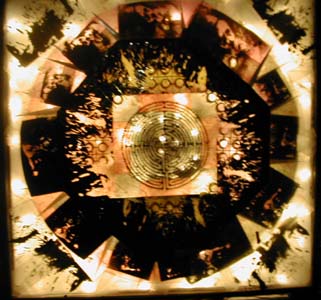
Dance of the Labyrinth
57 N St. NW
Washington, DC 20001
703-217-6706
by appointment only; suggested
days Thursdays or Sundays, 1-4pm
FREE (donation suggested)
http://www.labyrinthlights.com
http://www.labyrinthsforpeace.org |
You might think of labyrinths as places to
get lost in, but DC-area artist Sandra Wasko-Flood has designed one that
helps you find inner peace. Her creation, "Dance of the Labyrinth," combines
sculpture, photographic transparencies, interactive light boxes, and sound
in a computer triggered interactive environment. Visitors provide the performance
as they walk the steps of the labyrinth, moving through its six cycles,
until they reach the center�where they literally face themselves before
walking out transformed and renewed.
The moment you enter the room containing "Dance of the
Labyrinth," you�re pulled into a meditative inner space by the combination
of calming background music, cool darkness, swirling lights, and archetypal
images floating up from the floor and revolving on the walls. This imagery
incorporates the natural elements of Earth, Water, Fire and Air, as well
as psychological themes Wasko-Flood calls "Changing Elements" and "Merging
Elements." As you walk the spiraling footpath into the center, each touch-sensitive
glass panel lights up to reveal different surreal, black-and-white icons
formed from the combination of religious motifs: Nature goddesses and animal
totems, Russian Orthodox saints, Egyptian mummies, and macumba dancers.
The first section, dedicated to the Earth element, is
a physical path where images of the Madonna and Christ are superimposed
on the Earth. The Water section is an emotional path, where hybrid creatures
like a laughing, fish-eyed mummy leer up at you. The Fire section is dedicated
to the intellect, and involves images of worship. The Air section, dedicated
to the spirit, combines stars, hawks, and features the hybrid "monkey Madonna."
In the Changing Elements section, these images combine in a way that shows
them coming together. The Merging Elements section comes just before the
center and contains the most powerful images. When one reaches the center,
light strikes a mirror ball overhead, sending shards of light spinning
through the room; the traveler looks down into a mirror, where one�s own
reflection blends with the lights and images on the surrounding walls.
The walls feature dancing forms inspired by a vision Wasko-Flood experienced
in Chaco Canyon, New Mexico, in which Anasazi Indians danced the circular
canyon wall in a labyrinth motion. Groups of dancers alternate with four
revolving wheels, one for each element, incorporating corresponding imagery.
"They�re like Rorschachs, you bring what you know to them,"
Wasko-Flood says of her startling images. "I use these symbols to
unite people. People can walk for intentions, to solve problems, express
feeling, make a wish. You come in with concerns of the day and let go.
When you get to the center there�s a transformation, where one ideally
reaches enlightenment. As you walk back out to the starting point, you
travel through the cycle of life and death. You go in with life problems
and undergo a kind of death in the center; you walk out to be reborn, with
a fresh start."
She notes that most visitors to "Dance of the Labyrinth"
describe the experience using three words: "peace, power, and mystery."
�In our culture, the labyrinth has become a metaphor for
confusion," Wasko-Flood says. "I want to use the labyrinth as a metaphor
for life. The idea is you�re going through life's challenges. If you have
your faith and put one foot in front of another, you�ll reach your goal."
She�s quick to point out the distinction between mazes, which are designed
to trap and confuse, and labyrinths, which have been used in many different
cultures since antiquity as a ritualized meditative tool, with only one
continuous pathway that spirals into the center and back out.
"Dance of the Labyrinth" was first exhibited in 1994 at
Gallery 10 in Washington, DC. Wasko-Flood has also displayed a different
interactive labyrinth environment at Art-O-Matic, as well as many other
interactive light and sound constructions in other area galleries. A traveling
show called "Labyrinths for Peace," which was first shown on the east lawn
of the U.S. Capitol, involved �low tech� labyrinths marked out in the grass
and printed on canvas panels. Numerous churches use similar canvas labyrinths
as a meditative spiritual exercise.
You can make your own journey through the "Dance of the
Labyrinth" by appointment at Wasko-Flood�s studio, which doubles as the
Labyrinth Lights Center, her organization to promote peace, meditation
and contemplation through labyrinths. The center contains a small library
of labyrinth resources, and artworks featuring labyrinths.
|